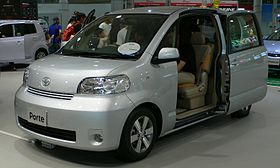Toyota Spade
| Toyota Porte | |
|---|---|
 |
|
| Overview | |
| Manufacturer | Toyota |
| Also called | Toyota Spade |
| Production | 2004–present |
| Body and chassis | |
| Class |
Mini MPV (2004–2012) Compact MPV (2012–present) |
| Body style | 3-door hatchback (2004–2012) 4-door hatchback (2012–present) |
| Layout | Front-engine, front-wheel-drive |
| Related | Toyota Vitz |
| Dimensions | |
| Wheelbase | 2,600 mm (102.4 in) |
| Length | 3,990 mm (157.1 in) |
| Width | 1,690 mm (66.5 in) |
| Height | 1,720 mm (67.7 in) |
| Chronology | |
| Predecessor | Toyota Raum |
The Toyota Porte is a compact MPV (mini MPV in its first generation) produced by Toyota that features an electric-powered sliding door on the passenger side, similar in approach to the Toyota Isis. The driver's door is of the conventional swing-open type.
The Porte was introduced in July 2004, but is only available in Japan, so it is only produced with right hand drive. The Porte is based on the Toyota Vitz subcompact car and is made in 4-seat and 5-seat versions.
It comes with either a 1.3 litre or 1.5 litre petrol engine, with automatic transmission only, and with either front wheel drive or all wheel drive. It is similar in concept to the Peugeot Sesame 2002 and the slightly smaller Peugeot 1007 which has an electric-powered sliding door on both sides. However the door only slides on the left.
In July 2012, the Porte was redesigned and for this generation, it introduced the Spade variant, which features a different front and rear design, as well as a slightly different interior color. The second-generation Porte is sold at Toyota Store and Toyopet Store dealerships while the Spade is sold at Corolla Store and Netz dealerships across Japan, as well as Hong Kong and Macau, starting in August 2015.
Although, it still comes with the 1.3-liter 1NR-FE engine or an improved 1.5-liter 1NZ-FE engine, mated with the Super CVT-i (Continuously Variable Transmission-intelligent) automatic transmission, an available Smart Stop feature for the 1.5-liter variants has a fuel efficiency of 20.6 km/L (58 mpg‑imp; 48 mpg‑US) under the JC08 test cycle (equivalent to 113 g/km (6.4 oz/mi) of CO2 emissions) of the Japanese Ministry of Land, Infrastructure, Transport and Tourism (MLIT). The two different engine sizes gave Japanese drivers a choice as to which annual road tax obligation they were willing to pay; vehicles with the larger engine were equipped at a higher level than the lower trim level in compensation.
...
Wikipedia
